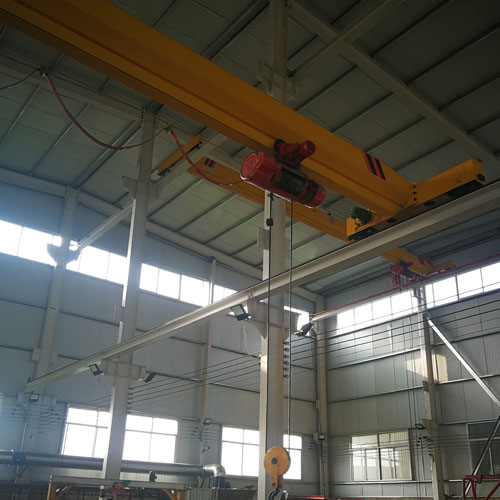In our daily production and life, there is often a need to transport heavy objects and lift them to higher places. In such situations, you require a lifting tool to assist you. This tool significantly enhances your productivity and work efficiency, saving manpower, reducing item damage, and minimizing personnel injuries.
Below, we will introduce some commonly used lifting tools
Overhead Cranes

An overhead crane, also known as a bridge crane, is a lifting equipment positioned above workshops, warehouses, and material yards for loading and unloading operations. It can traverse longitudinally along the tracks laid on both sides of the bridge structure or transversely as the trolley moves along the tracks on the bridge. This allows efficient utilization of the space beneath the bridge, enabling the lifting of goods without being hindered by ground obstacles.
Overhead cranes are capable of meeting the lifting requirements for various heavy-duty goods. They offer excellent stability, and strong load-bearing capacity, and find wide applications in diverse industries.
Hoists and Winches
Hoists and winches are both lightweight lifting tools, with standard lifting capacities ranging from 250kg to 20T, not exceeding 100T. They can be operated manually or electrically, with lifting mechanisms using either chains or steel wire ropes.
Manual hoists include lever hoists and chain hoists, characterized by their simple structure, convenient operation, easy maintenance, portability, and widespread applicability. They are the most common type, boasting the highest sales figures.
Electric hoists come in various types, ranging from household electric hoists dominated by mini electric hoists, scaffold electric hoists to specialized lifting equipment such as electric chain hoists and wire rope electric hoists. Electric hoists feature mature technology, compact structure, smooth operation, and user-friendly design, significantly saving manpower. They can be used independently or mounted on single-beam, double-beam, or cantilever cranes with I-beam tracks.
Winches are divided into manual winches and electric winches, primarily used for traction, rescue operations, and facility installations. Originating from vehicle-mounted winches, they are now widely used in fields such as firefighting, yachting, agriculture, environmental protection, and more.
Pallet Truck and Stacker
Material handling equipment includes various types such as small carts, manual hydraulic pallet trucks, manual stackers, semi-electric stackers, and fully electric pallet trucks. These are devices designed for stacking, transporting, loading, and unloading entire pallet loads, especially for short-distance transportation.
Among these, hand hydraulic pallet trucks are the most common material handling carts. With a simple structure, stable quality, and flexible manoeuvrability, they are indispensable equipment for pallet handling and container loading in supermarkets, warehouses, workshops, logistics centres, and freight yards.
Stackers, with a standard maximum lifting height of 3600mm, are commonly found in warehouses with shelving, workshops, and material distribution centres. They are essential tools for storing, stacking, and facilitating the turnover of goods.
Material handling equipment significantly enhances work efficiency, reduces the physical strain on workers, and minimises the risk of item damage. Moreover, with the advancement of artificial intelligence, unmanned, automated material handling equipment is widely adopted in automated warehouse systems.
Lifting Rigging And Slings
Lifting rigging and slings items mainly refer to woven straps such as lifting slings, ratchet tie-down, and tow straps, also including wire rope slings, lifting chain slings, lifting pulleys, clamps, various shackles, hooks, clips, turnbuckles, and other complementary accessories for lifting equipment.
Lifting slings primarily refers to polyester slings, including round slings and webbing slings, with capacities ranging from 1T to 100T. These slings can reach lengths of up to 100 meters, offering lightweight, flexibility, wear resistance, and corrosion resistance. Depending on the application and environmental requirements, you can choose the appropriate safety factor, with options of 4x, 6x, and 7x.
Tensioners and trailer straps are widely used for securing objects during goods transportation and storage processes, providing simple and reliable operation for enhanced safety.
There is a wide variety of rigging accessories, often used in conjunction with lifting equipment, slings, steel ropes, and more. When selecting rigging accessories, it is crucial to consider factors such as the work environment, types of lifted items, and their weights to ensure compatibility with the lifting equipment.
Conclusion
The above items are commonly used lifting tools and accessories in both production and daily life. If you are unsure about how to make the right choice, feel free to contact us. Liftpand has a team of professional technicians ready to assist you!

